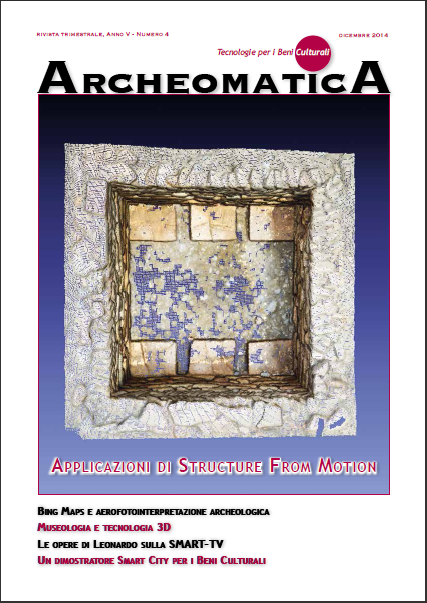Bing Maps: aerofotointerpretazione archeologica online. La visione panoramica "made in Microsoft”
DOI:
https://doi.org/10.48258/arc.v5i4.882Parole chiave:
Archeologia Aerea, Topografia Antica, Fotografia Aerea, Archeologia, Nuove TecnologieAbstract
In the last years, the aerial archaeology confirmed the importance and the potentiality of aerial photography in the study of landscape that already was realized by Giacomo Boni, Franz Stolze and O.G.S. Crawford between the late nineteenth and the early twentieth century. Aerial photography is today a tool used in numerous fields: from geology to civil engineering, from the study of the environment to the identification of pollution sources, from architecture to archeology; in fact it is becoming a valid and indispensable tool for the study of the ancient topography. In this last field, the aerial photograph is really important if it is used as instrument of knowledge and research. The aerial view is sure the most useful tool for observe the modern landscape and all evidence or "marks” that would be unintelligible if they are observed from the ground. The great diffusion of internet has made possible the creation of catalogues that allow consulting maps, orthophotos, aerial and oblique images online; the Italian regions have decided to publish all data on internet with the creation of websites (WebGIS). However, it is possible to encounter serious difficulties in finding the photographic material because of high costs and long times, but thanks to the use of Bing Maps, a web mapping service of Microsoftâ„¢, it is possible to break down such restrictions. Bing Maps has high resolution oblique photographs, so called "Bird's Eye”, that allow to realize a free virtual aerial survey thanks to combined use of aerial and oblique images. This approach has been used to observe the modern landscape of Veio obtaining new archaeological useful data, without cost, for the reconstruction and update of ancient topography of Etruscan town.Riferimenti bibliografici
Bartoloni G. (2009), L'abitato etrusco di Veio, Ricerche dell'Università La Sapienza di Roma, volume I, Cisterne, pozzi e fosse, Roma: Edizioni Iuno.
Bartoloni G., Reggi A., Turchetti R., Torelli M. (2010), Guida archeologica del parco di Veio, Subiaco: Edizioni Parco di Veio.
Ceraudo G., Piccarreta F. (2000), Manuale di Aerofotografia Archeologica. Metodologia, tecniche e applicazioni, Bari: Edipuglia
Drago Troccoli L. (1998), Scavi e ricerche archeologiche dell'Università di Roma La Sapienza, Roma: L'Erma di Bretschneider.
Guaitoli M. (2003), Lo sguardo di Icaro. Le collezioni dell'Aerofototeca Nazionale per la conoscenza del territorio, Roma: Edizioni Campisano.
Moretti Sgubini A.M. (2001), Veio, Cerveteri, Vulci. Città d'Etruria a confronto, Roma: L'Erma di Bretschneider.
##submission.downloads##
Pubblicato
Come citare
Fascicolo
Sezione
Licenza
Gli autori che pubblicano su questa rivista accettano le seguenti condizioni:- Gli autori mantengono i diritti sulla loro opera e cedono alla rivista il diritto di prima pubblicazione dell'opera, contemporaneamente licenziata sotto una Licenza Creative Commons - Attribuzione che permette ad altri di condividere l'opera indicando la paternità intellettuale e la prima pubblicazione su questa rivista.
- Gli autori possono aderire ad altri accordi di licenza non esclusiva per la distribuzione della versione dell'opera pubblicata (es. depositarla in un archivio istituzionale o pubblicarla in una monografia), a patto di indicare che la prima pubblicazione è avvenuta su questa rivista.
- Gli autori possono diffondere la loro opera online (es. in repository istituzionali o nel loro sito web) prima e durante il processo di submission, poiché può portare a scambi produttivi e aumentare le citazioni dell'opera pubblicata (Vedi The Effect of Open Access).





